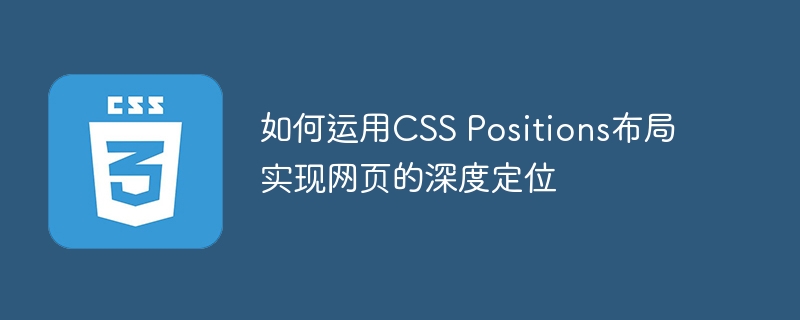所属分类:web前端开发

如何运用CSS Positions布局实现网页的深度定位
在网页设计中,深度定位是一种重要的技术手段,可以帮助我们精确地定位和布局元素。通过使用CSS的Positions属性,我们可以将元素定位到文档流之外,实现更加灵活和精确的布局效果。本文将介绍如何运用CSS Positions布局实现网页的深度定位,并提供具体的代码示例。
Positions属性包括四个值:static(静态定位,默认值)、relative(相对定位)、absolute(绝对定位)和fixed(固定定位)。下面将分别说明这四种定位方式的特点以及如何使用它们来实现深度定位。
静态定位是CSS默认的定位方式,元素处于文档流中的位置不受其他定位属性的影响,无法通过设置top、right、bottom和left来改变其位置。静态定位一般用于无需特殊定位的元素。
示例代码:
<div class="box">
<p>This is a static positioned element.</p>
</div>
<style>
.box {
position: static;
}
</style>相对定位是相对于元素在文档流中的初始位置进行定位。可以通过设置top、right、bottom和left属性来调整元素的位置,但相对定位不会使其他元素的位置发生改变。
示例代码:
<div class="box">
<p>This is a relatively positioned element.</p>
</div>
<style>
.box {
position: relative;
top: 10px;
left: 20px;
}
</style>绝对定位是相对于其最近的具有定位属性(非static)的父元素进行定位。如果没有找到具有定位属性的父元素,将以文档的初始位置为参考进行定位。通过设置top、right、bottom和left属性可以精确地控制元素的位置。绝对定位会使其他元素的位置发生改变,因此要谨慎使用。
示例代码:
<div class="container">
<div class="box">
<p>This is an absolutely positioned element.</p>
</div>
</div>
<style>
.container {
position: relative;
width: 300px;
height: 200px;
background-color: lightgray;
}
.box {
position: absolute;
top: 50px;
left: 50px;
background-color: pink;
}
</style>固定定位是相对于浏览器窗口来定位的,即使滚动页面,固定定位的元素也会保持在指定的位置。通过设置top、right、bottom和left属性可以调整元素的位置。固定定位常用于创建悬浮元素、导航栏等固定在页面上的元素。
示例代码:
<div class="fixed-box">
<p>This is a fixed positioned element.</p>
</div>
<style>
.fixed-box {
position: fixed;
top: 50px;
left: 50px;
background-color: lightblue;
}
</style>